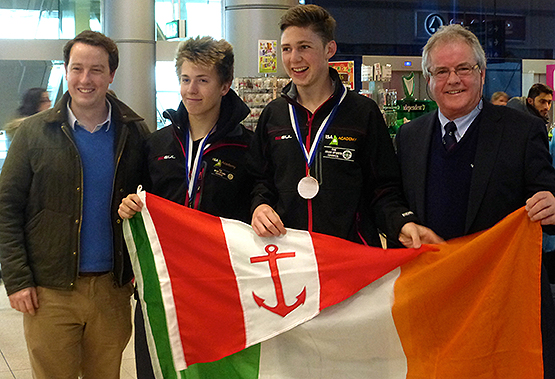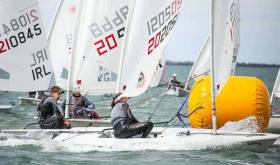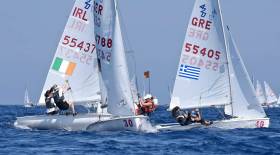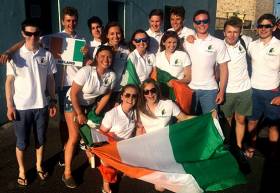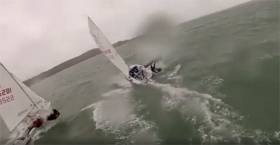Displaying items by tag: 420
Over 130 boats took to the water today at Ballyholme Yacht Club on Belfast Lough on Day 1 of the ISA Youth Pathway National Championships and Optimist Trials. The event is supported by Ards & North Down Borough Council. Only 2 courses were sailed today with the Topper and Laser 4.7 fleets starting tomorrow instead.
On the Optimist course, 3 races were completed in a light steady westerly breeze- the first two races saw all of the competitors behaving themselves on the start line but the eager youngsters couldn't help themselves on the final start with a single general recall under Race Officer Harry Gallagher.
The sailors from Royal Cork Yacht Club showed the strongest form with 13 year old Justin Lucas winning the first two races and Cillian Forster the last. First Junior overall after Day 1 is Luke Turvey from Howth YC in 7th whilst first lady is Emily Riordan from Royal St George in Dun Laoghaire. Four races are scheduled for thw Optimists tomorrow.
On Course 1, Gemma McDowell and Emma Gallagher lead overall in the double-handed 420 class with 1,2,2 from Kate Lyttle and Niamh Henry (3,4,1)
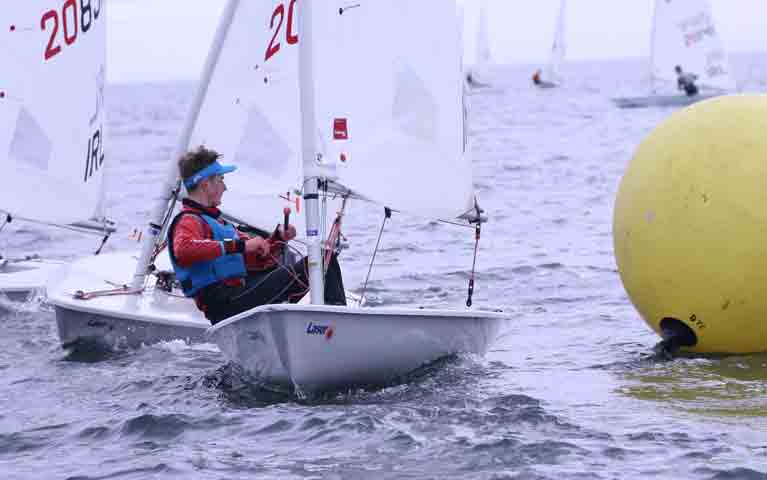 Laser Radials reach the weather mark in the first race of the ISA Youth Championships. Photo: Simon McIlwaine
Laser Radials reach the weather mark in the first race of the ISA Youth Championships. Photo: Simon McIlwaine
The Laser Radial fleet is the glamour fleet this weekend with ISA Performance squad members Howth's Ewan McMahon and Cork's Johnny Durcan battling it out with future ISAF Youth Worlds selection in view later this year - however Aaron Rogers from Rush leads overall with 1,2,1. Royal North's Sally Bell leads the ladies.
Racing continues until Sunday with 4 races scheduled for the Optimists and 3 for the other classes starting at 11:00 tomorrow. Tomorrow night Olympic Silver Medallist Annalise Murphy will be present to give a welcome and a talk to all the youth sailors on how to campaign for future international success.
Annalise Murphy To Share Expertise At ISA Youth Sailing Championships in Northern Ireland
Annalise Murphy is just one of four evening talks taking place at the ISA Youth Sailing National Championships, being held at Ballyholme Yacht Club, 19-23 April. As Afloat.ie reported previouslty, it is the first time the event has been sailed in Northern Ireland.
The evening talks as well as the races are open to all young sailors who sail in the five ISA Youth Pathway Classes (Laser Radial, Laser 4.7, 420, Topper, Optimist). This is Ireland’ largest Youth regatta and the ISA’s primary talent spotting event of the year for the Academy and Junior classes. The ISA squad programmes will resume this summer in the Laser 4.7 and Topper classes, and these classes will have a squad trial to identify future ISA Pathway sailors. In addition, ISA spotters are out to assess sailors for Academy trials for the Laser Radials and 420s. (The Optimists will have separate Class-organised talent spotters).
Eight places on the ISA Topper Squad
In the Topper class up to eight sailors will be selected to join the ISA Topper Squad. The Squad coach and programme will be announced following the event. The programme aimed at developing young Topper sailors will provide training and also support at the 2017 Topper World Championship to be held in Brittany, France in July. Entry to the World championship is independent of ISA squad selection and through the International Topper Class Association.
Five places on the ISA Laser 4.7 Squad
Up to five sailors will be chosen at the ISA Youth Pathway Nationals to join the ISA 4.7 Squad. A further two sailors may be chosen at the 2017 Laser 4.7 Ulster Championship. The ISA 4.7 squad will provide training to help young sailors transition in the Laser 4.7 class. It will also aim to prepare and support the squad for the Laser 4.7 World Championship to be held in Nieuwpoort, Belgium in July. The squad coach and programme will be announced following event. Entry to the 4.7 Worlds is independent of ISA squad selection through the International Laser Class Association.
A line–up of big name evening speakers – including Annalise Murphy – open to all:
At 5.30pm each evening there will be a talk and Q&A session at the Ballyholme Yacht Club with speakers who have a deep knowledge of racing. The talks are open to all sailors and parents.
Full list of Evening Speakers:
Wednesday 19th April, BILL O'HARA will discuss “What to consider when preparing for an event - Rules Strategy for racing”. Bill is the current Principal Race Officer for the Volvo Ocean Race, International Umpire and Rules adviser to the Irish Olympic Team.
Thursday 20th April, Annalise Murphy (Olympic Silver medalist) will share her insights in a talk entitled “Beat the Best: Preparing for Competitive Gains at the Olympics”.
Friday 21st April, Matt McGovern (Double Olympian 49er Class) will talk on “Team Work in Sailing – Preparing a Professional Approach”
Saturday 22nd April, Ross Killian & Russell McGovern (ISA Performance Coaches) will give video analysis and coaching tips from the day’s racing.
420 National Dinghy Title Goes to Elmes/O'Sullivan in Record Fleet at Howth Yacht Club
There was plenty of wind over the past three days as the 2016 420 Nationals took place at Howth Yacht Club.
Steady wind on the first two days ensured that Race Officer Derek Bothwell was able to keep on schedule for the first two days with two races on Day 1 and three on Day 2.
A record 25 boats attended the event, including four visiting boats from the UK. From the outset, HYC's Douglas Elmes and Colin O'Sullivan led the event, although they met with challenges from Geoff Power and James McCann who won Race 2, and GBR pairing Katie Davies and Madeleine Watkins who won Races 3 and 5.
The final day, Thursday, saw a sharp increase in wind strength and in the interest of safety a decision was taken to stand down the Silver fleet. Three races were completed by the Gold fleet, with Elmes / O'Sullivan retaining their lead and retaining their title from 2015. Power / McCann displayed their rising talent by taking second place in the Gold fleet .
Careful planning of the event had allowed UK sailors to attend this year without clashing with their own Nationals and the overseas visitors were warmly welcomed, with a charming thank-you speech from first overseas sailors Davies / Watkins acknowledging the excellent sailing and race management, and the camaraderie between the entire fleet.
In addition to the Overall Nationals trophy, this year a new First Irish Ladies trophy was presented, to Kate Lyttle and Niamh Henry of RSGYC, and as part of the Class attempt to encourage new sailors to the fleet, National Optimist coach Thomas Chaix crewed for SSC's Ella May, taking first place in the Silver fleet.
The efforts of the Association to encourage new sailors to the Class, in conjunction with the obvious success of present and ex-420 sailors - HYC's Ewan MacMahon taking second overall in the 2016 Worlds, RCYC's Harry Durcan / Harry Whitaker today taking first in the 29er National Championships, and Elmes/O'Sullivan's bronze medal in the 2015 ISAFs - seem to be paying off, with the largest number of competitiors in recent history creating an extremely successful event.
Results are here.
On the last day of the qualifying series of the 2016 420 World Championships in Sanremo, Ireland's best results of the day were achieved by Cliodhna Ni Shuilleabhain and Niamh Doran with two top ten results ensuring their place in the Gold fleet. They join Gemma and Cara McDowell, who had a consistent day putting them in 12th overall.
In the under 17 fleet Geoff Power and James McCann also made the Gold fleet. Douglas Elmes and Colin O'Sullivan will sail in the Gold fleet of the Open event
There were very light winds again yesterday with sailing not getting going until after 3pm and the girls division racing continuing until 7pm.
The priority on race day 3 was to get the qualification stage wrapped up for the 420 Open and 420 Ladies fleets, and confirm the teams advancing to the gold and silver splits for the 6 race final series.
All fleets headed out to the race track for midday, but the weather gods had other plans. Postponement on the water, as another windless morning threatened the patience of the most resilient sailors. Eventually, the wind swung to the west, enabling racing to get underway soon after 1500 hours in a testing 6-8 knot breeze.
420 LADIES
All change in the leaderboard pegging in the 84 boat 420 Ladies, as Francesca Russo Cirillo/Alice Linussi accelerated through the fleet to take the overall lead. A masterclass of sailing from this pair, with wins in races 4 and 5, and a fourth in the final race of qualification in the blue fleet giving them a 2 point advantage over Maria Caba/Pilar Caba (ESP). Russo Cirillo is familiar with front of fleet pressure, as two years ago at the 2014 420 Worlds she won gold. Back then she was at the front of the boat, switching to helm last year.
Overnight leaders Julia Szmit/Hanna Dzik (POL) drop to third. A phenomenal performance from Spain’s Maria Bover Guerrero/Clara Llabrés, banked them two race wins in the yellow fleet, and a leaderboard climb to 4th, up from 9th this morning.
A first win in the bag of the series to Italy’s Veronica Ferraro/Giulia Ierardi pushes them up into 6th overall.
The gold fleet cut was for those finishing 42nd or above from the 6 race qualification series, with all teams below the cut-off now racing in silver. A 100% conversion rate for Ireland, with both of their Ladies teams advancing to gold.
For the rest of the nations, disappointment for some, as only the top 42 best performers now continue the battle for a chance at World Championship podium glory.
420 Ladies - Top 10 after 6 races
1. Francesca Russo Cirillo/Alice Linussi (ITA 55476) - 12 pts
2. Maria Caba/Pilar Caba (ESP 55687) - 14 pts
3. Julia Szmit/Hanna Dzik (POL 56008) - 16 pts
4. María Bover Guerrero/Clara Llabrés (ESP 54697) - 17 pts
5. Sofia Giondi/Giulia Gatta (ITA 55914) - 19 pts
6. Veronica Ferraro/Giulia Ierardi (ITA 56042) - 23 pts
7. Maria Vittoria Marchesini/Cecilia Fedel (ITA 55641) - 24 pts
8. Jessie Kampman/Léa Sibertin-Blanc (FRA 55896) - 25 pts
9. Souzana Bakatsia/Nikoletta Papageorgiou (GRE 55002) - 28 pts
10. Sofie Schöne/Line Johanna Thielemann (GER 56064) - 29 pts
420 OPEN
France’s Jim Vincent/Victor Mas edge into the lead by 3 points, leapfrogging overnight leaders, Theo Carayon/Erwan Lucas (FRA), who slip to second on a 1 point deficit. These two have consolidated their lead, holding a useful 9 points margin over the rest of the pack.
The renowned Portuguese brothers and Diogo Costa/Pedro Costa have stepped up, thrusting through into the top ten in third, in a significant climb of 11 places. They are the Portuguese 420 National Champions, for the second year.
Behind the top three teams, the scorecard is incredibly close, with just an 8 point margin between 4th through to 10th places.
The 55 gold fleet teams are now poised for final series racing, and set to take on their biggest challenge of the Championship so far, with all the top teams pitched against each other. Two races are scheduled on Thursday, with a 1000 hours start.
420 Open - Top 10 after 6 races
1. Jim Vincent/Victor Mas (FRA 55096) - 15 pts
2. Theo Carayon/Erwan Lucas (FRA 54834) - 16 pts
3. Diogo Costa/Pedro Costa (POR 55289) - 25 pts
4. Otto Henry/Sam Worrall (AUS 55157) - 35 pts
5. Wiley Rogers/Jack Parkin (USA 55162) - 37 pts
6. Enrique Luján/Pablo Luján (ESP 56077) - 37 pts
7. Fausto Cruz Peralta/Martin Arroyo Verdi (ARG 54842) - 37 pts
8. Luca Valentino/Giacomo Bandini (ITA 56024) - 40 pts
9. Vasilios Gourgiotis/Orestis Batsis (GRE 54484) - 41 pts
10. Maxime Pedron/Ange-Loup Stimbre (FRA 55881) - 43 pts
420 U17
Two races for the 68 team under-17 fleet, propelled Telis Athanasopoulos Yogo/Dimitris Tassios (GRE) into the lead. The Greeks effectively matched the performance of Violette Dorange/Camille Orion (FRA) today, as with the discard kicking in at race 5, both teams achieved scores of 1,4 - reversed across the two races.
The French pair, who led going into the day, are one of two girls teams now remaining inside the top 10 in this highly competitive fleet of 420 Class teams aged 16 and under.
Spain’s Eduard Ferrer/Carlos De Maqua break into the top 10, gearing up to third overall after discarding their radical 46th score from yesterday’s race 2, and building in promising results of 4,1 today.
A disaster of a performance from Carlotta Scodnik/Camilla Scodnik, who opened yesterday’s assault in 7th overall, but plummeted to 25th by the end of the day after two black flag (BFD) penalties for being over the starting line early. One BFD is discarded, but the other counts on their scorecard. They now have a mountain to climb to break back into the top 10.
Introduced in 2015, the under-17 division has attracted a whole new breed of young 420 teams to the Worlds, who are keen to race within their own age group. As with the 420 Open and Ladies fleets, strict quotas apply limiting the number of teams a nation can enter, to ensure only the best young sailors in the world qualify to compete at the 420 World Championships.
420 U17 - Top 10 after 5 races
1. Telis Athanasopoulos Yogo/Dimitris Tassios (GRE 56071) - 8 pts
2. Violette Dorange/Camille Orion (FRA 55959) - 9 pts
3. Eduard Ferrer/Carlos De Maqua (ESP 55980) - 15 pts
4. Enzo Balanger/Gaultier Tallieu (FRA 56030) - 17 pts
5. Luis Doreste/Julio Alonso (ESP 55539) - 28 pts
6. Aina Colom/Victoria Sisk (ESP 55987) - 31 pts
7. Alessandro Venini/Alessandro Bernardo (ITA 56046) - 35 pts
8. Tommaso Cilli/Bruno Mantero (ITA 56076) - 41 pts
9. Nick Zeltner/Till Seger (SUI 55553) - 43 pts
10. Giorgos Drosos/Nikolaos Giotopoulos (GRE 53456) - 49 pts
Racing on Thursday’s Championship day 4 will feature 2 races for the 420 Open and 420 Ladies fleets, in their first day of final series racing, and 3 races for the U17 fleet who continue a single series race format. First starts for all classes will be at 1000 hours.
Malahide 420 Sisters Cara & Gemma McDowell Off to Flying Start at World Championships
Wind finally arrived this afternoon at the 2016 420 Worlds in Sanremo, Italy. All three fleets, open, ladies and under 17, completed three races before the wind dropped again.
Malahide YC sisters Cara and Gemma McDowell set a high standard for the 7-boat Irish team with a second in race one, finishing the day in seventh overall.
Howth YC pairing Douglas Elmes and Colin O'Sullivan got off to a good start with an eighth in race one ending the day in 11th place.
No Breeze for 420 Teams in Italy
Opening day of racing at the 2016 420 World Championships in Sanremo, Italy, where 14 Irish sailors are competing, did not quite live up to expectations as the breeze failed to kick in.
The Race Committee chanced their luck and sent the 420 Open and 420 Ladies out to the race tracks off Marina degli Aregai, but the zephyrs of breeze failed to convert and any hope of racing was abandoned.
In contrast and exceeding expectations however, is the huge strength of fleets competing. An all-time record has been set at the 2016 420 World Championships of 524 sailors facing each other on the race track. Fleet splits are:
• 420 Open - 110 teams from 22 nations
• 420 Ladies - 84 teams from 21 nations
• 420 U17 - 68 entries from 18 nations
In an attempt to get racing back on schedule, the schedule for Tuesday 20 July is three races for all fleets, with the first starts scheduled for 1000 hours.
CHAMPIONSHIP OPENS
After three days of measurement and registration, yesterday's Opening Ceremony saw the 420 Worlds officially unveiled and parade of nations arrive in Baden Powell Square at the heart of San Stefano, a short distance east of Marina degli Aregai where the Worlds are taking place.
The racing schedule features 12 races for each fleet, with the 420 Open and 420 Ladies split into yellow and blue to race a 6 race qualifying and 6 race final series, with the 68 boat U17 fleet racing a 12 race single series.
420 OPEN
Featuring 110 teams from 22 nations, the 420 Open fleet will be a battleground for the world’s best junior 420 talent. Most of the teams are male, with a few mixed male/female teams in the line-up, reflecting the accessibility of the class.
The leaderboard is all open, with only a handful of teams who made an appearance in last year’s World Championship top ten leaderboard returning for another shot at the podium. Japan won gold last year, but with that partnership now advanced to Olympic 470 class sailing, the favourites must be the USA’s Wiley Rogers/Jack Parkin.
This punishingly accurate team won the 2015 420 Junior Europeans off the back of their bronze medal at the 2015 420 Worlds, and has won plentiful honours since. Rogers/Parkin has dominated at every 420 event they have contested recently, including last month’s Kieler Woche which featured over 160 teams in the 420 fleet. Add to that the experience they have gained since transitioning to the 470 Class, their Olympic steed of choice, so no question they are on a mission to seize the gold medal and wrap up their competitive 420 Class careers in style.
Also featuring in the line-up are the 4th and 10th placed finishers from 2015, Greece’s Vasilios Gourgiotis/Orestis Batsis and France’s Maxime Pedron who is now racing with Ange-Loup Stimbre.
Looking to boost their profile and stepping up to senior fleet racing in the Open fleet are all three of the podium finishing teams from last year’s U17 fleet. Each is capable of mounting a credible bid for the Championship, with U17 420 World gold medallists, Edoardo Ferraro/Francesco Orlando from home nation, Italy headlining the charge. Since their convincing win last year, the pair has proved themselves worthy of the senior fleet challenge, counting top 10 results at all recent events contested.
Also well up in the mix are a prevalence of reigning National 420 Class Champions. Brazil’s André Fiuza/Marcelo Peek to New Zealand’s Josh Berry/Henry Haslett, Portugal’s Diogo Coasta/Pedro Costa to Spain’s Marc Llado/Antoni Massanet and Switzerland’s Maxime Bachelin/Arno de Planta - have all proved themselves more than capable of National Championship glory. Will they make the grade for a World Championship podium finish?
420 LADIES
All change in the 420 Ladies fleet and an open race card with only three of last year’s top ten placing teams returning for another shot at podium glory. Mano Udagawa/Mino Ohashi (JPN) who finished 7th, Sofia Giondi/Giulia Gatta (ITA) who finished 9th and tenth placed Margot Vennin/Marie Zugolaro (FRA) will be intent on an upgrade, as the fleet dynamic changes this year.
Don’t overlook the fact that 2014 420 Ladies World Champions, Carlotta Omari/Francesco Russo Cirillo, who now compete in separate partnerships have all the depth of experience required to claim control of the leaderboard. 2016 Italian 420 National Champion, Omari is racing with Matilda Di Stefano, whilst Cirillo has switched to helming and teamed up with Alice Linussi. Both teams hold the advantage of many days of pre-Championship training on the same waters as the 420 Worlds – so you can expect a fiery assault from both teams when racing kicks off tomorrow.
As in the 420 Open, there are numerous podium leading ladies team more than capable of dominating the race track. Winners of the British Youth Nationals, Isabel Davies/Gemma Keers, Evaggelia Drouga / Eua Maria Vardali (GRE) who won Athens Eurolymp Week and many more top class 420 ladies teams have all the ingredients to make this a battle to the end.
420 U17
Introduced for the first time in 2015, the 16 years and under division offers younger 420 sailors the opportunity to measure up against rivals in their own age group. A critical performance pathway as younger teams advance into senior careers, boosted by their competitiveness against similar aged rivals.
More than double the number of entries, 68 teams in 2016 compared to 33 in 2015, will contest this division, as the 420 Class’ young raw talent faces off in a battle of wills.
Amongst the many names to watch are Violette Dorange/Camille Orio (FRA) who stamped their intent, by finishing 2nd overall last week in the 85 boat 420 fleet at the keenly contested French 420 National Championships.
Team Ireland Race at the 420 Worlds, Italy
The 2016 420 World Championships opened last night in San Remo, Italy. This year sees the largest ever number of competitors (256) with three competing fleets, Open, Ladies and Under 17.
14 sailors are representing Ireland at the event, Cliodhna Ni Shuilleabhain and Niamh Doran (KYC/CSC), Gemma and Cara McDowell (MYC), Kate Lyttle and Niamh Henry (RSGYC), Geoff Power and James McCann(WHSC / RCYC), Shane McLoughlin and Patrick Whyte (HYC / MSC), Ronan Cournane and Ben Walsh (KYC / SSC) and Douglas Elmes and Colin O'Sullivan (HYC), supported by coaches Ross Killian and Graeme Grant.
The Opening Ceremony was held last night and racing begins today, continuing until Saturday 23rd. Results will be available from the event website
Ireland had success in the dinghy at world youth level in January, winning a bronze medal in Malaysia.
420 Helmsman Goes Overboard in Schull Training Mishap
Champion youth sailor Harry Durcan of Royal Cork took a swim during heavy weather training at last week's 420 dinghy training camp in Schull, West Cork. The near miss between the two 420s was captured on video and can be seen below.
Following on from the Schull session, the next 420 training will take place in Cork Harbour on March 5th. The training will be led by Ross Killian, ISA National Coach with an assistant coach on the water. Cost will be €50 per sailor/€100 per boat for the weekend, which will go ahead subject to a minimum of 4 boats.
420s Announce Munster Champs & Coaching at Schull This February
The Irish 420 class will stage its 2016 Munster Championships and open coaching session at Schull Sailing Centre during the February Mid-Term break.
Coaching will take place from Saturday 13th (registration only) to Tuesday16th February with Ross Killian - ISA National Coach - leading the coaching team. The Munster Championships will take place on Thursday 18th and Friday 19th.
The Committee are currently looking at accommodation options and will announce full details of both events in the coming days.
How Ireland Won Bronze At the Youth Sailing Worlds
As a vehicle sport dominated by weather conditions, sailing can be difficult enough to explain to the outside world. But when you factor in the constantly changing situation which is youth sailing, where crew dynamics of size, weight and attitude can change with bewildering rapidity, it becomes very complex indeed.
Yet despite the inevitable fluidity, Ireland has long had a vibrant youth sailing scene. And it’s on a roll right now, with the Irish crew of Doug Elmes and Colin O’Sullivan returning this week from the Youth Worlds on the other side of the planet with a Bronze Medal in the 420, while the bonus is that all of the team of four came home from the championship with very solid performances recorded. Liam Glynn returned with 15th out of a fleet of 66 in the Laser Radial Boys, while Aisling Keller was tenth out of 55, also in Laser Radial. W M Nixon tries to capture the mood of the moment, and the machinations behind the 420 crew’s special success.
It could well be that there was only a window of opportunity of maybe six months or even less in which Doug Elmes of Kilkenny and Colin O’Sullivan of Malahide could have been realistically in the frame for a podium place racing the 420 in the Youth Sailing World at Langkawi in Malaysia in the final week of 2015.
The 420 is a gallant little boat, but young sailors outgrow them very quickly. And then before you know it, they’re too old anyway. Elmes, who is now 17, and O’Sullivan, who will become 17 in March, have known each other, and got on well together, since they first met while racing Optimists when aged eleven. But it wasn’t automatic that they should team up to sail 420s, instead of choosing the usual solo junior sailing career path of going on to maybe a year or two in Toppers, and then on into the Laser.
Sailing pundits bewail the fact that our junior sailing is dominated by single-handed boats. But the logistics of campaigning a two-person boat on the national and international circuit at junior level are extremely challenging. The most basic problem is that neither crewmember will have a driving licence. Thus they’re totally reliant on family or organisational support for boat movement, and in the end it almost invariably means that two families will be totally involved.
The level of mutual goodwill required across the generations and between at least two households is extremely high, so it’s not surprising that ISA Coach Ross Killian – he marks ten years as a fulltime sailing coach this year – reckons that a realistic figure for the Irish 420 fleet with genuine potential hovers around the 15 mark, and the going is good when the number of serious participants gets up to 20 boats.
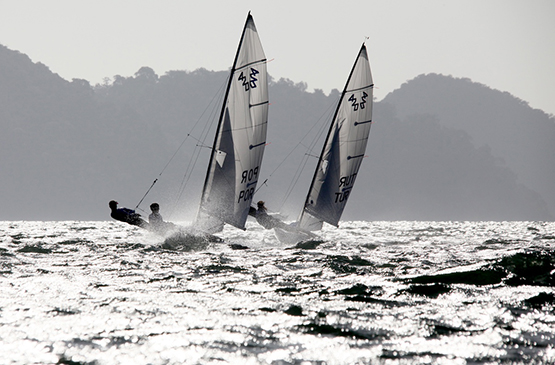
A sailing paradise. The Portuguese and Turkish crews revelling in the perfect 420 sailing conditions at Langkawi.

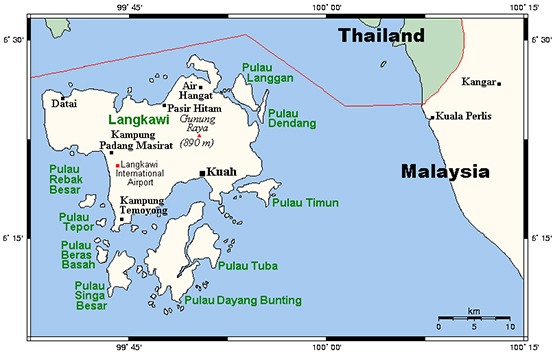
The paradise island provided one problem - getting the boats delivered there had a significant “Just In Time” aspect.
In such a small fleet, inevitably the volunteer administrative work will fall to a few. You get a notion of the compact size of the national operation when you realize that the Irish President is John Elmes of Waterford Harbour SC in Dunmore East, who also happens to be Doug Elmes’ father, while the Class Secretary is Joan O’Sullivan of Malahide who – you’ve guessed it – is Colin O’Sullivan’s mum.
Yet as regular Afloat.ie watchers will be well aware, on Tuesday when the successful team returned to a rapturous welcome in Dublin Airport, the 420 crew found themselves immediately wrapped in the tricolour and the Howth YC burgee, and it’s in the Howth club tomorrow that they’ll be officially welcomed home.
This neatly illustrates the fact that the Irish 420 focal point is a moveable feast. For now at any rate, it’s Howth which happens to be providing the national centre. It is currently coming up with the numbers, and in club coach Graeme Grant it has one very talented individual who inspires the young people to reach the level at which they can be taken under Ross Killian’s wing for the international circuit.
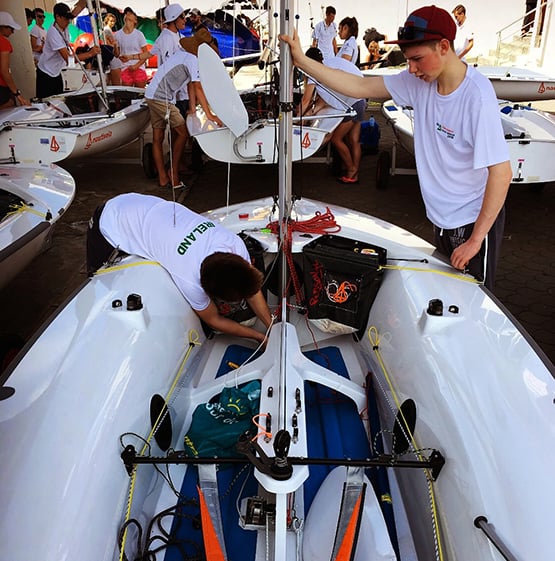
Colin O’Sullivan holds the mast in place as the 420s are rigged and Doug Elmes turns his skills to sorting a technical problem on the boat, which was delivered to the venue at the last moment. Photo: Ross Killian
But it’s a matter of catching the talent when all the stars have the potential to be in alignment, and in the final analysis it’s the young crews themselves who have to show the spark that will be fanned into the flame of success.
Of the successful crew, it was Colin O’Sullivan who first felt the 420 urge. He remembers it very well. He was thirteen-and-a-half at the time, and though he could have had another couple of years with the Optimists, he was growing tall, and so he got involved with 420 sailing, crewing for Ewan McMahon of Howth.
Meanwhile Doug Elmes – who had been concentrating on sailing Optimists at Crosshaven with the RCYC - was soon feeling the same way, and he in turn teamed up to move on to 420 racing with Bill Staunton of Skerries, which tells us something of the truly national nature of Optimist racing.
But when we look at the 420 in detail, it’s to realise that while she’s a very serviceable little boat, the fact that she’s precisely and only 4.2 metres long makes it inevitable that with today’s bigger and faster-growing youngsters, their 420 compatibility period can be very brief indeed, and they have to keep an eye out for potential new crewmates.
Thus when MacMahon and Staunton outgrew the 420, Elmes and O’Sullivan decided to become a crew, and their debut together was at Wexford in September 2014. They’ve been fine-tuning their act ever since, with the busy little class at Howth providing the stage, and they make for a very balanced duo in a boat which is central to world youth sailing.
The virtue of the 420 is that she’s as small and economical as you can get while still having the crew on a trapeze. The boat has been around for more than half a century now, having been designed by Christian Maury to a specification devised by the chief instructors at a sailing school in southwest France. But as she’s one of those boats that looks much better when fully alive and sailing well than she does on the plans, it took a long time in the 1970s before anyone in Ireland would accept the contention, put forward by Sean Clune of the National YC, that the 420 was the only way to go for Irish junior sailing.
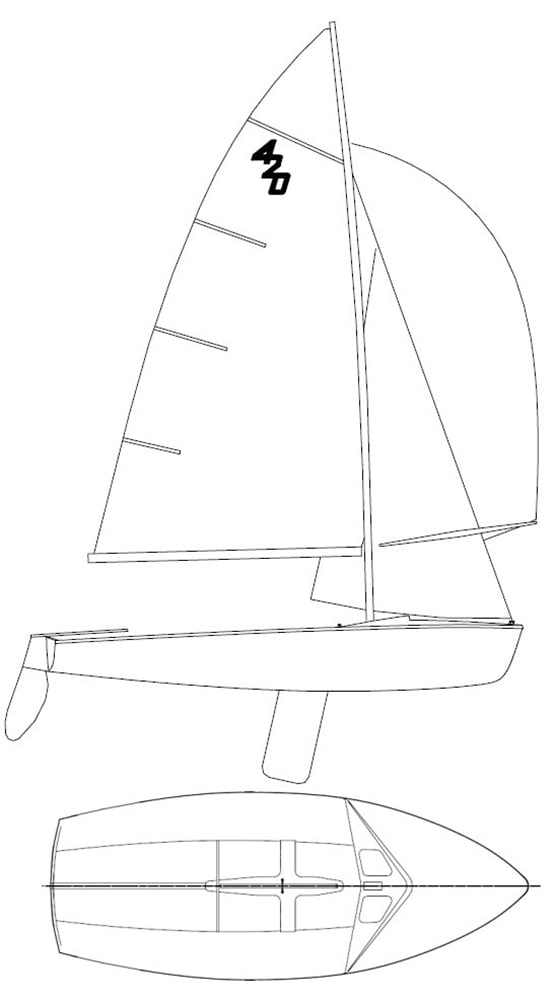
The International 420 is one of those boats which looks better when she’s sailing (below) than she does on the plans (above)

But for those young people who wanted a boat which was minimum hassle to maintain yet providing a proper grown-up sailing experience, the 420 was the future here and now, and it has the advantage of being family-friendly in that, though you’ll need the help of your folks to get the boat to a championship destination, they won’t have to shell out on a 4X4 for a towing vehicle, while it has long been a class tradition that at major international events, the host nation has to provide boats.
So all you have to do is provide the talent and the dedication……Well, there’s more to it than that, of course. But for now, let’s just celebrate the fact that a young sailor from Ireland’s only significant inland town which is not an official waterways port, teamed up moreover with another young sailor who learned his skills on the unique Broadmeadow Water at Malahide, has done the business on the sunny seas of southeast Asia with coolness and style.
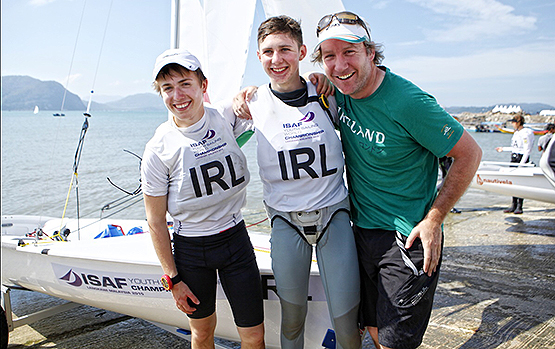
The job done – with their Bronze Medal secured, Doug & Colin get together with coach Ross Killian.
It was classic stuff. As Graeme Grant says of their development: “They have been always improving results and skills through dedication and hard work”. And as Ross Killian attests: “They’re just so cool under pressure, and they balance each other”.
As Colin O’Sullivan loyally asserts, it’s Doug Elmes who is the techno-genius. They arrived in the island of Langkawi to find paradise and perfect sailing conditions – but no boats. There’d been a foul-up in the fleet delivery schedule. The boats arrived at the last minute, so the trial race was the very first sail. But Doug was in his element putting it all together, and their boat was as race prepared as any in the fleet.
As the series progressed, it came down to the wire for the Bronze Medal between Ireland and Australia. In the crucial race, it was the Australian coach who commented to Ross Killian on the stylish coolness of the Irish crew, and watched in open-mouthed admiration as Elmes carried off a mark-rounding with such skill that he picked up three places at a stroke.
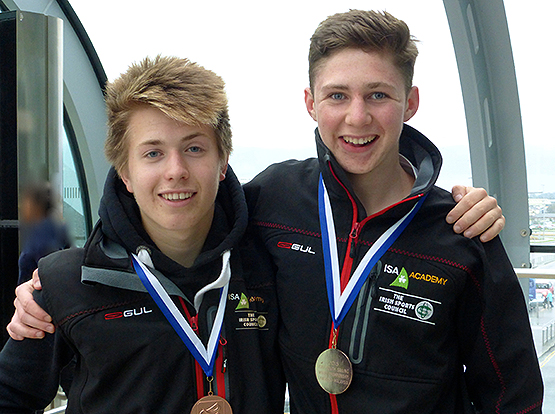
Thereafter, the commentators on the shared coach-boat were favourably impressed by the way the Irish kept the race and their place under quiet yet total control, avoiding the temptation to throw everything away by being unnecessarily greedy.
The day after their return to Ireland, we spoke with Colin O’Sullivan after he’d done some serious catching-up on sleep, yet with typical dedication had dragged himself out into the winter night for his routine session at the gym. The big question with a crew of two is how much they talk during a race. The answer in this case is that since teaming up less than 18 months ago, the Elmes-O’Sullivan crew have upped the talk level with every event, yet it has become more focused each time out. “At Langkawi, we were exchanging information all the time, the talk was constant” says O’Sullivan with a chuckle, “but you definitely wouldn’t call it chat”.
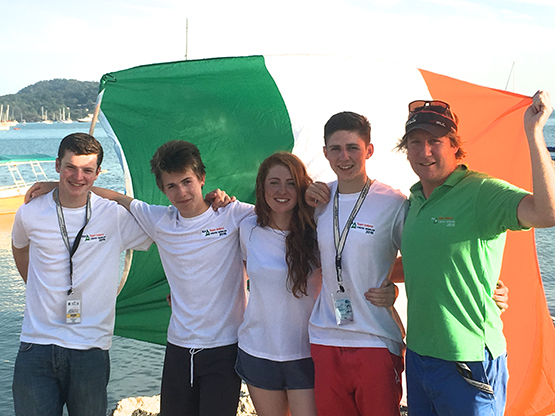
At the conclusion of a good Youth Worlds for Ireland are (left to right) Liam Glynn, Doug Elmes, Aisling Keller, Colin O’Sullivan and Ross Killian.
